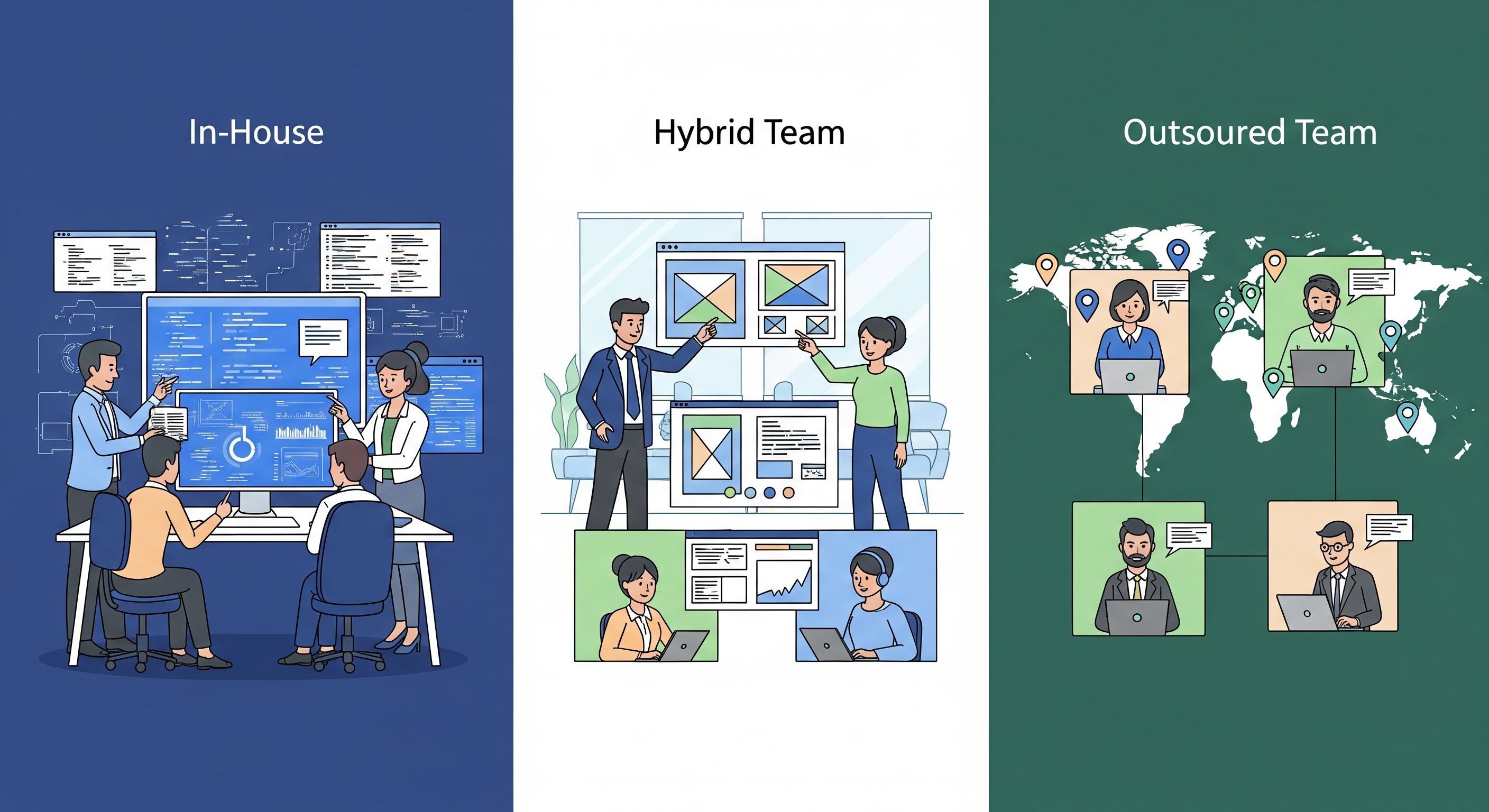Weigh in-house vs outsourced product engineering for fintech startups. Compare costs, security considerations, and time-to-market factors for U.S. fintech scale-ups.
Why This Decision Matters
For U.S.-based fintech CTOs and engineering leaders, choosing to outsource or maintain engineering internally impacts speed-to-market, compliance, scalability, and innovation.
Since 2020, 73% of financial services organizations accelerated digital transformation, reducing mean fintech product lead times from 18–24 months to 6–12 months. Yet, 67% of fintech startups fail pre-Series B, generally due to slow delivery or compliance.
Outsourcing:
Fees: $50–$150/hour for fintech-specialized teams
Savings: 40–60% of direct costs (20–30% net after overhead)
Overheads: Project management (15–25%), QA (20–30%), onboarding delays (4–8 weeks), time zone inefficiencies (10–20%)
In-House:
Salaries: $150K–$250K/year for lead engineers
Benefits & equity: +25–40% of salary
Recruiting: $15K–$30K/hire
Infrastructure: $2K–$5K/engineer/year
12-Month Total:
Outsourced: $500K–$1M
In-House: $1.05M–$1.9M
Security & Compliance
Key Regulatory Needs: SOC 2, PCI DSS, GLBA, CCPA, GDPR, and state-specific laws like NY BitLicense.
Need to launch your fintech MVP in months, not years?
Whether you’re targeting Series A readiness or racing to meet compliance deadlines, our specialized fintech engineering teams can help you deliver faster—without sacrificing security.
Talk to a fintech product expert.
Outsourcing Checklist:
SOC 2 Type II & ISO 27001 verification
Data processing agreements & breach notification clauses
Background checks for vendor employees
Code escrow & IP security
In-House Strengths:
Direct management of protocols
Faster incident response
Easier compliance audits
Drawback: Security expertise is costly and hard to hire.
Speed-to-Market
Outsourcing Advantages:
Immediate team availability
Create DevOps pipelines & compliance templates
Work cycles 24/7 across time zones
In-House Challenges:
Hiring & onboarding: 3–6 months
Learning the domain: 2–4 months
Slower MVP delivery

Typical Timeframes:
MVP: Outsourced 4–6 months | In-House 8–12 months
Series A readiness: Outsourced 8–12 months | In-House 12–18 months
Compliance readiness: Outsourced 6–9 months | In-House 12–18 months
Technical Skills
Outsourcing Strengths:
Payments, open banking APIs, blockchain, fraud detection
AI/ML, analytics, mobile-first design
Broad regulatory expertise
In-House Advantages:
Deep product understanding
IP ownership
Faster internal iterations
Risk & Control
Outsourcing Risks:
Vendor lock-in & IP disputes
Communication or quality gaps
Compliance risks to regulations
Complex vendor exit
In-House Control:
Complete IP ownership
Direct supervision
Alignment with business objectives
Hybrid Approaches:
Keep core IP internal; outsource non-core modules
Long-term vendor relationships
Gradual knowledge transfer to minimize dependence
Decision Guide for CTOs
Best for Outsourcing:
Can go live in <12 months
Limited internal leadership
Need specialized expertise
Should be able to maximize cash flow
Best for In-House:
The competitive differentiator is proprietary tech
Strong technical leadership
Funding horizon >18 months
High security/control requirements
Hybrid Approach
Variation in complexity by product/feature
Seasonal or project-based loads
Piloting with outsourcing as pathfinding to scaling
Case Studies
Outsourcing:
Digital Lending Startup – MVP within 8 months, SOC 2 compliance 6 months early, $800K in cost savings, and Series A funding achieved ahead of time.
Insurtech App – iOS & Android launch in 6 months, 4.8-star ratings, 60% cost savings, backend in-house.
In-House:
3. Payment Processor—In-house fraud rules, sub-200 ms processing, scaled to $1B+ volume.
4. Crypto Exchange – Complete security control, 99.99% uptime, proprietary trading algos, regulatory ease of compliance.
Future Trends
AI/ML: Proprietary algos at the center; outsource first, then internalize.
Cloud-Native: Scalability is simpler, both models benefit.
RegTech: Compliance by third parties reduces custom build needs.
Hybrid Dominance: Most fintech scale-ups will blend in-house leadership with outsourced expertise by 2026.
FAQs
Q1: Fintechs cost how much less to outsource compared to in-house?
Outsourcing is 40–60% lower in direct cost ($50–$150/hour vs. $150K–$250K/year salaries), but net savings after overhead are roughly 20–30%.
Q2: How do fintechs have security while outsourcing?
Screen suppliers for SOC 2/ISO 27001, do background checks, keep DPAs on hand, review code regularly, and implement zero-trust architectures.
Q3: The principal outsourced fintech development risks are:
Vendor dependence, IP dispute, regulatory failure, and exit sophistication. Minimize by having good contracts, ongoing monitoring, and in-house technical stewardship.
Q4: Months to construct a fintech MVP for every solution?
Outsourced: 4–6 months; In-House: 8–12 months, mainly because of recruitment and ramp-up time.
Q5: Should fintechs move from outsourcing to in-house as they grow?
They usually begin outsourced for economics and speed, then subsequently introduce central features in-house following Series A and the outsourcing of commodity features.
Make the right call for your fintech’s future.
Outsourced, in-house, or hybrid—your decision will shape your product’s speed, security, and scalability. Let’s map out the most cost-effective, compliant, and investor-ready approach for your next build.
Book your strategy session now.
![]()







